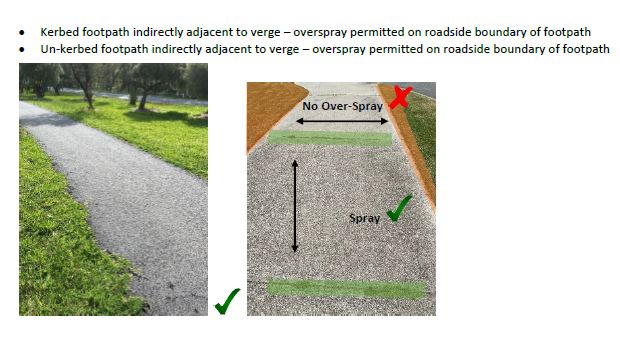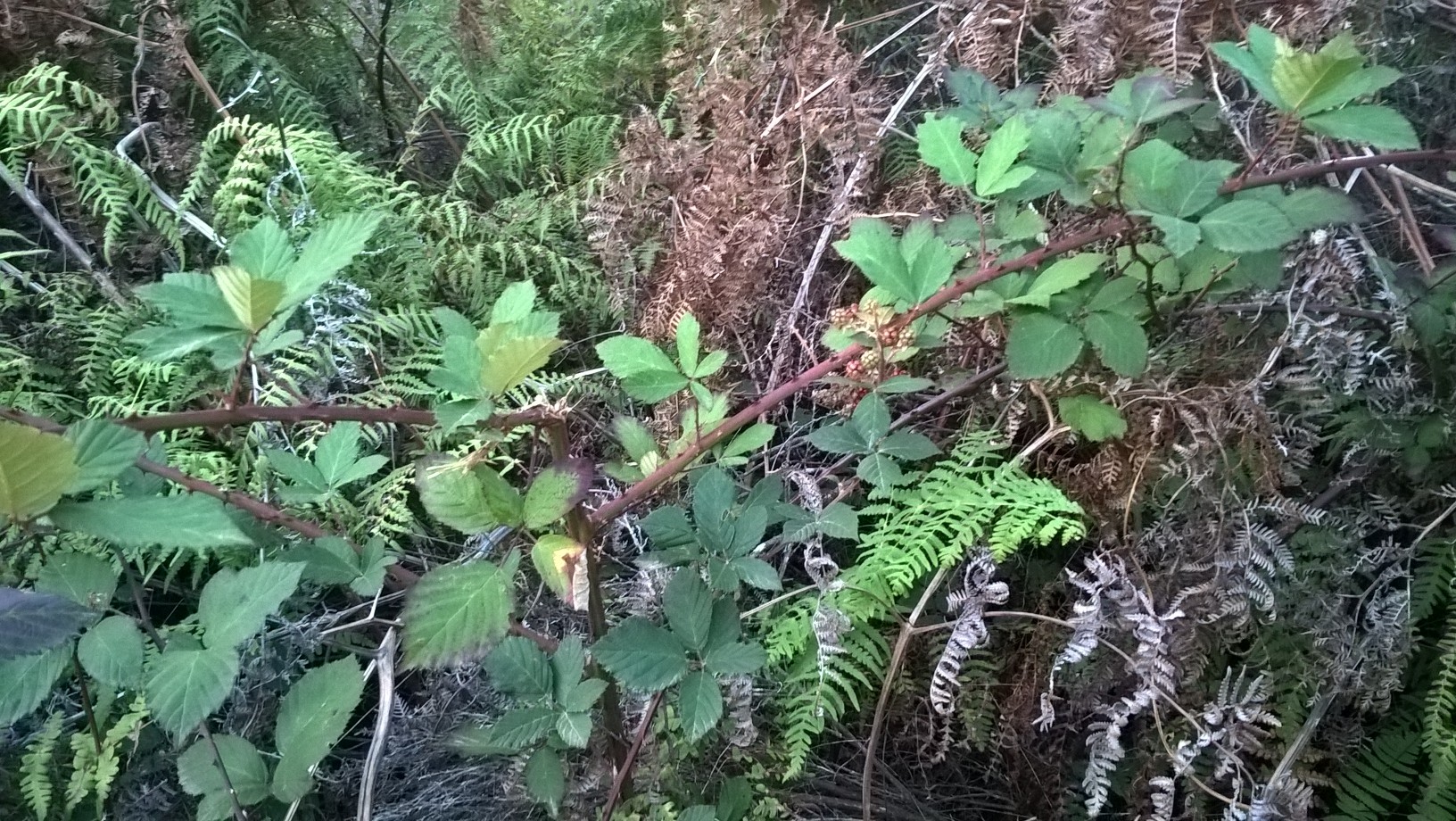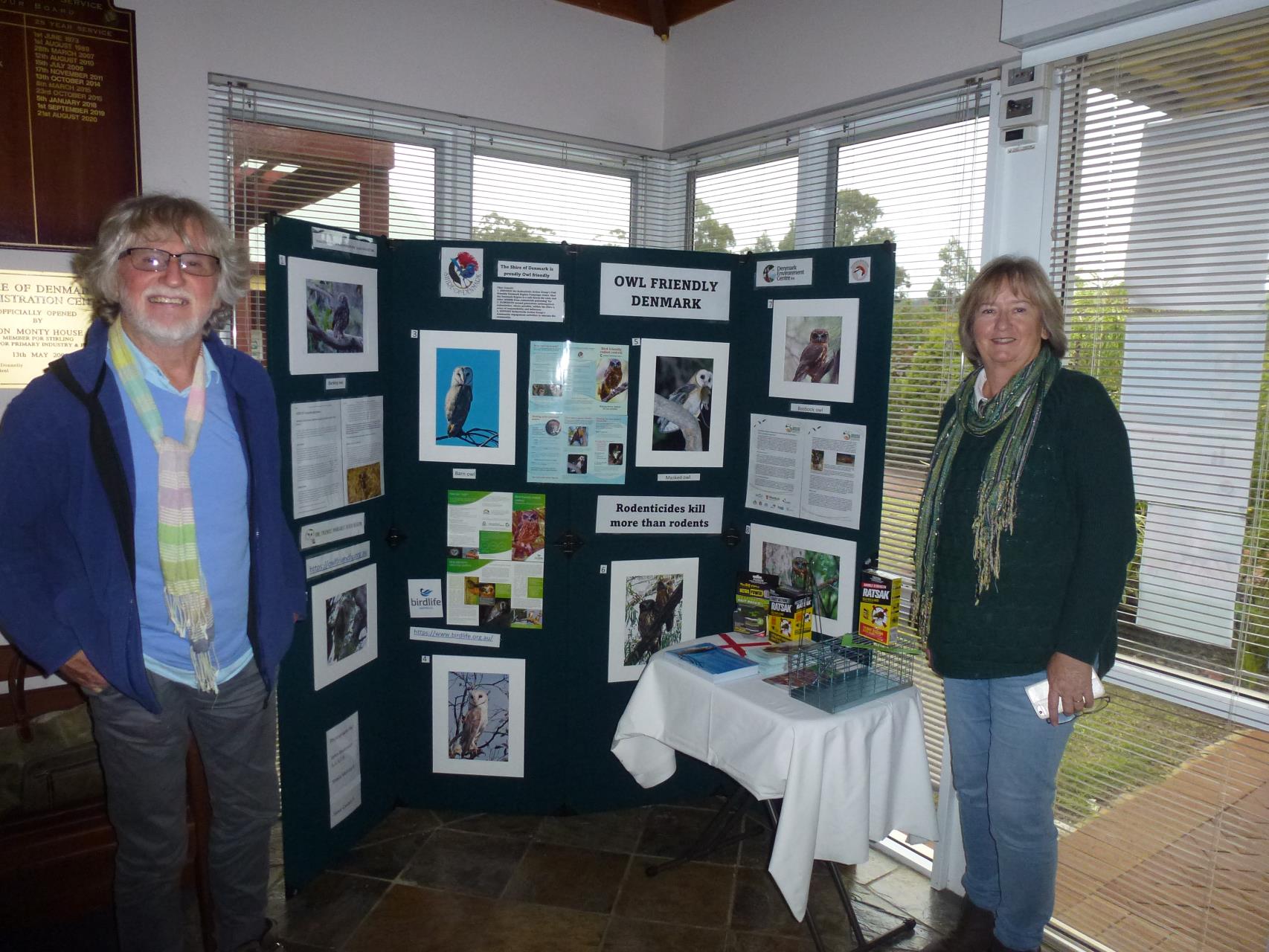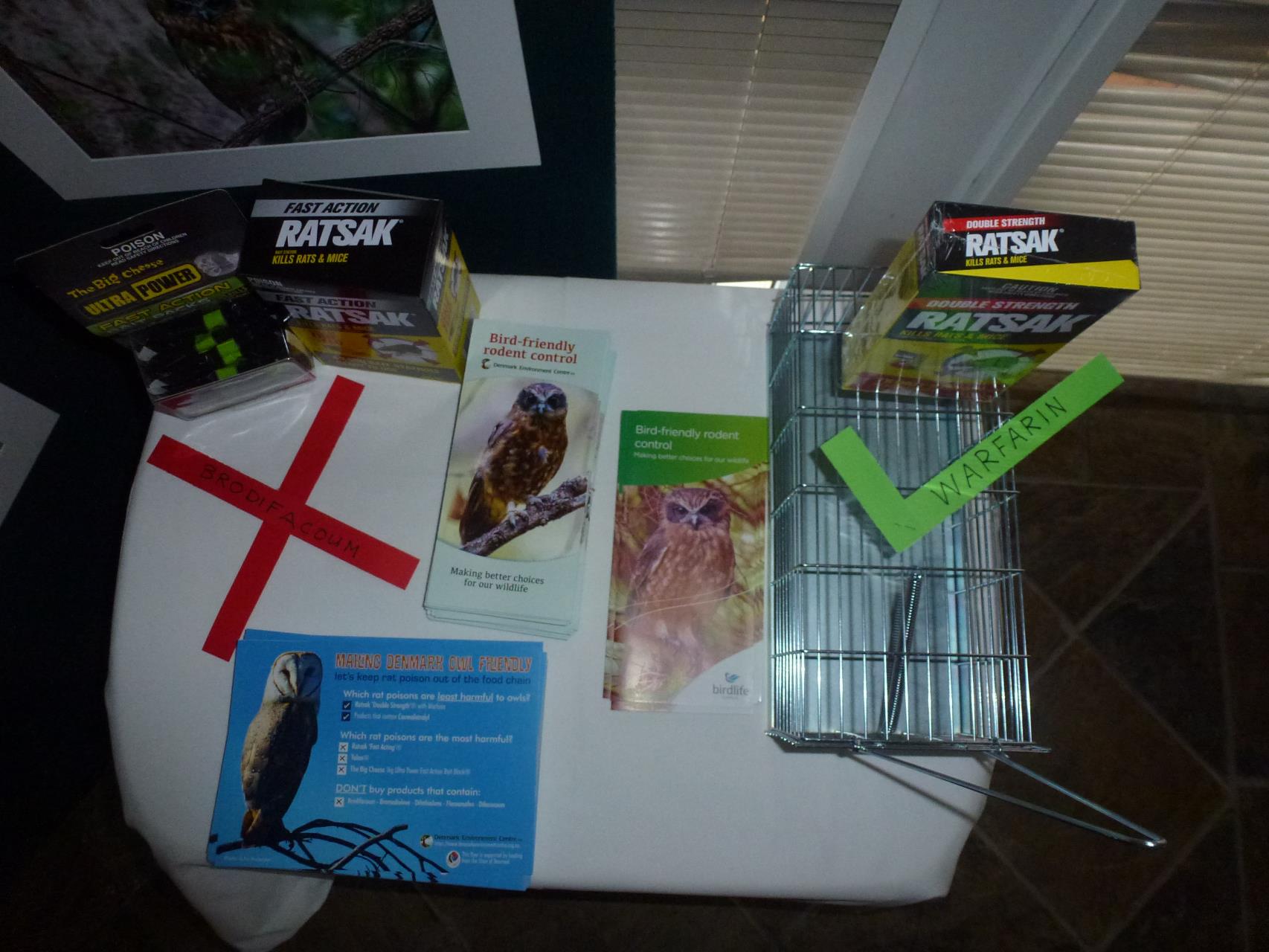Weeds
A Weed is defined as “a plant considered undesirable, unattractive, or troublesome, especially one growing where it is not wanted...”.
65% of weeds on the South Coast have derived from ornamental garden plants. Many of these popular garden plants, including some eastern states Australian natives, are extremely invasive and can spread into adjacent native bushland areas. Due to their speed of growth and reproductive methods they have the ability to out-compete the naturally occurring plants in areas of native bushland and subsequently deprive the native fauna species of their habitat and dietary resources.
Some of these highly invasive plants found in the Shire of Denmark are listed as priority weeds at either a National, State or Local level, and include (but not limited to):
- African Love Grass (Eragrostis curvula) – a Shire of Denmark Pest Plant
- Bridal Creeper (Asparagus asparagoides) - a State-listed Declared Plant and Shire of Denmark Pest Plant
- Dolichos pea (Dipogon lignosus) – a Shire of Denmark Pest Plant
- Sweet Pittosporum (Pittosporum undulatum) – a Shire of Denmark Pest Plant
- Sydney Golden Wattle (Acacia longifolia) – a Shire of Denmark Pest Plant
- Taylorina (Psoralea pinnata) – a Shire of Denmark Pest Plant
- Victorian Tea-tree (Leptospermum laevigatum) – a Shire of Denmark Pest Plant
- Lantana (Lantana camara) – a State-listed Declared Plant and Weed of National Significance
- Blackberry (Rubus anglocandicans) – a State-listed Declared Plant and Weed of National Significance
- Arum Lilly (Zantedeschia aethiopica) - a State-listed Declared Plant
- Watsonia spp. – a Shire of Denmark Pest Plant
While control and prevention of spread of State-listed Declared Plants is prescribed under the WA Biosecurity and Agriculture Management Act 2007, the Shire of Denmark also has powers under the Act to enforce control of plants it considers as pests. These are prescribed under the Shire’s Local Law Pest Plant Schedule.
Should you have these species occurring on your property you are required to remove and consider establishing alternative native plants in your garden. Local native plants require less gardening maintenance, less watering requirements and provide for native fauna.
Some methods of weed control that you can actively perform include:
- Learn to identify invasive weeds and pest plants – observe and report
- Dispose of garden waste safely (proper composting ensures weed seeds do not spread)
- Avoid growing problem plants – plant natives instead
- Avoid plants which have prolific seed (eg. Agapanthus and Polygala)
- Avoid plants which spread easily by layering (eg. Honeysuckle)
- Avoid plants which are spread by birds (eg. Bleeding Heart)
- Remove seed heads to help prevent further spread
- Participate in working bees on weed control in your local area
For advice on control and identification of weeds, contact the Shire of Denmark on phone 08 9848 0300.
Shire Weed Control Spray Program
The Shire of Denmark undertakes a Weed Control Program to manage invasive weeds on it's road verges and within Shire reserves for the purposes of infrastructure maintenance; targeted noxious weed management for biodiversity conservation; and for fire mitigation and post-burn weed control . Weed control activities including mechanical and manual weed removal, as well as chemical spraying occur at different times of the year dependent upon species targeted, weather considerations, and works programming.
No Spray Register
If you wish to have the boundaries of your property excluded from the herbicide spray program you can apply to the Shire to be included on the No-Spray Register for Road or Reserve Frontage Maintenance, in accordance with Shire Policy P120104. Property owners can request verge areas adjoining their properties not be sprayed, with the understanding that you will then undertake responsibility for the weed management on the road verges surrounding your property. Please click on the following links to access the No Spray Register Application form and associated Policy

Sydney Golden Wattle

Sydney Golden Wattle (Acacia longifolia)
The Shire undertakes weed control works across the Shire cross-tenure of the invasive weedy wattle Sydney Golden Wattle (Acacia longifolia). The Shire has been mapping known and reported sightings of SGW, with a dedicated Shire Officer engaged to ground-truth locations with a view towards eradication of these populations. The Shire has subsequently engaged local contractor Green Skills Ecojobs to undertake weed control works on Sydney Golden Wattle infestations occurring on Shire road reserves and reserves at over 40 locations across the Shire throughout the months of September and October. In conjunction with these actions the Shire has also appealed to private property owners to remove this pest plant by issuing a letter to ratepayers where SGW has been noted as occurring on their property.
Sydney Golden Wattle is a dense bushy shrub or small tree to 10m and can be identified by their cylindrical yellow flower spikes, and long dark green leaves with 2-3 longitudinal veins. Although native to the eastern states, it has the capacity to take over and out-compete native Western Australian flora. These wattles are fast-growing and seed prolifically with long dormancy rates which can crowd out the native bush, and can act as a fire hazard. Some treatment options to control the plant are by hand removal of small plants and seedlings, or by cutting down larger plants at ground level. It is important to undertake weed control prior to the plant producing seed. Seeds persist in the soil for approximately 10 to 20 years, so follow up control will be required.
Over a number of years there has been a collaborative effort by state government agencies, community weed action groups and the Shire of Denmark, to work towards eradicating this plant from the south coast region. Pursuant to the Shire of Denmark Local Law Relating to Pest Plants, Sydney Golden Wattle is listed as a Pest Plant within the First Schedule, and the cooperation of the community in achieving this goal is necessary to help protect and restore the natural biodiversity of the area.
“It is important that the Shire works collaboratively with the community on taking action on this particular well known pest plant to keep on top of problem weed species like SGW so that we can continue to keep our beautiful bush areas intact and free from these invasives.” said Shire of Denmark Sustainability Officer Yvette Caruso.
To view the Media Release on SGW please visit: https://www.denmark.wa.gov.au/news/sydney-golden-wattle-blitz-in-denmark/20848
Blackberry Herbicide Spraying
Blackberry herbicide spraying is undertaken on the Shire of Denmark’s bushland Reserves and Road Reserves throughout February to April. The spraying is part of a strategic plan to control invasive, declared weeds and pest plants in the Shire in accordance with the Shire of Denmark’s Weeds Strategy and Action Plan.
Spraying will be conducted by licensed contractors and will target local, state and nationally listed weeds, including Blackberry (Rubus sp.), Taylorina (Psoralea pinnata), Madiera Vine (Anredera cordifolia) and Sweet Pittosporum (Pittosporum undulatum). The community is reminded to always avoid picking Blackberries from bushland and Road Reserves, in the event they may have been sprayed. Spraying will not occur adjacent to properties listed on the Shire’s “No Spray Register”.
For further information please contact Yvette Caruso - Sustainability Officer on telephone 9848 0346 or email yvette.caruso@denmark.wa.gov.au

Blackberry (Rubus sp.)
Weeds Documents
Shire of Denmark Weeds Strategy & Action Plan 2005 - 2010
Shire of Denmark Local Laws Relating to Pest Plants
Invasive Weeds & Native Flora Information Sheet
Environmental Weeds of Denmark brochure
Weeds Fact Sheet (digital version)
Weeds Fact Sheet (print version)
Weedy Wattles Brochure
Weedy Wattles Brochure (one page)
Glyphosate Fact Sheet: Safety and Use
WALGA Fact Sheet - Integrated Weed Management Practices
WALGA Fact Sheet - Benefits and Limitations of Weed Control Methods
WALGA Fact Sheet - Chemical weed spraying - FAQ's
WALGA Fact Sheet - Protection of Public Health and Environmental Values
WALGA Fact Sheet - Weed Control on Private Property
WALGA Fact Sheet - Local Government Weed Management Working Group
Weeds Website Links
Department of Primary Industries and Regional Development
Biosecurity and Agricultural Management in WA
Western Australian On-Line Herbarium
Bushland Weeds: A Practical Guide to their Management
Weeds of National Significance
Feral Animals
Introduced animals such as foxes, feral cats, pigs and rabbits can have devastating impacts on the natural environment by destroying habitat, spreading diseases, predation and competing with native animals for habitat and food resources.
Feral Pigs
The feral pig’s method of foraging for food by rooting of soil causes physical soil structure damage, erosion and affects soil fauna. Rooting reduces the ground cover, sometimes changes the composition of plant communities and can encourage invasion by weeds. Pigs can also feed directly from native plants and compete with native wildlife for resources such as habitat and food. Pigs can affect the quality of water in catchment areas and can spread exotic plant diseases including Phytophthora cinnamomi, the pathogen responsible for dieback. Baiting and cage trapping can be used to control feral pigs. The Shire contributes annual funding towards feral pig eradication in the Denbarker northern areas of the Shire.
European Red Fox
The fox was deliberately introduced to Australia for hunting in the late 1800s and soon became established over most of Australia. It will eat almost anything and has been blamed for being a major cause in the decline of many native species, as well as the predation of lambs. Control largely relies on conventional techniques, such as shooting, fencing and baiting (SEWPaC 2010). Use of the 1080 poison (available as meat or egg baits) is available to trained landholders from the Department of Agriculture and Food. Contact the Denmark Department of Agriculture and Food’s office on phone 08 9848 1756.
European Rabbit
Rabbits directly compete with native animals for food and cause localised and severe degradation of pasture and bushland. This, as well as their burrowing and warrens, often results in erosion. Rabbits also eat close to the ground, so cause a significant impact to regenerating native vegetation and pasture species. There are a number of control techniques available for rabbits, including biological control (release of the rabbit haemorrhagic disease and Myxomotosis), shooting, den fumigation and baiting using 1080 or Pindone (State of Western Australia, 2003). Contact the Department of Agriculture and Food for specialist advice on a method of control to suit your property or visit the links below.
Feral Cats
PET CATS (domestic, owned) live with and are generally dependent on humans for food and habitation; they are socially important and are legally permitted in Australia. There is legislation in most states regarding ownership and variable requirements to register, sterilise and identify (i.e. microchips, collars) the animal.
STRAY CATS (semi-feral) are often found in and around urban areas, rural properties, industrial areas, refuse tips and wastelands. They are either in self-sustaining populations or become stray following neglect or irresponsible pet ownership; some depend on resources provided by humans, but they are generally not registered. Most strays are not desexed or vaccinated but some may have been a pet cat at some stage of their life.
FERAL CATS live as wild animals in self-sustaining populations in natural habitats of all types, detached from humans and survive exclusively by hunting and scavenging.
The Shire of Denmark provides Sheffield cage traps for hire to the public. Please refer to the current Shire of Denmark Fees & Charges Schedule for hire costs. When hiring a trap, the Shire refers the public to the RSPCA Guidelines for the Use of Humane Cat Traps: a copy is available from the Shire Office. All animals, domestic or wild, native or feral need to be managed humanely.
Impacts of Cats in Australia
Impacts of Pet Cats on Australian Wildlife
The Wilson Inlet Catchment Committee (WICC) is 1080 baiting in the Wilson Inlet Catchment
If you are interested in baiting (or already bait) on your property then WICC would love to partner with you in order to help control feral animals in the catchment. WICC will be using 1080 Canid Pest Ejectors. This system is permanently fixed and cannot be translocated by birds. In order to deliver the best possible outcomes, WICC will also be seeking to bait on all neighbouring properties to yours. For more information, see the WICC website.
Secondary Generation Anticoagulant Rodenticides (SGAR)
In March 2021, the Shire of Denmark endorsed the Rodenticide Action Group’s Owl Friendly Denmark Region Campaign’s vision for the Denmark Region as ‘a safe haven for owls and other wildlife from rodenticide poisoning’. Council committed to eliminate second generation anticoagulant rodenticides where possible within the Shire’s area of responsibility and influence, and support the Rodenticide Action Group’s community engagement activities to educate the community.
The Shire is looking to promote a community education workshop in 2021 in collaboration with the Denmark Environment Centre on raising awareness of the impacts of SGAR on raptors and many other birds and mammals. First generation anticoagulants such as warfarin and coumatetralyl have a higher rate of breakdown so do not persist in the food chain for as long as SGAR. As a result, first generation anticoagulant rodenticides are considered less of a risk to our native predators and pets who may prey upon affected rodents. Please see the following information about the impacts of SGAR's.
Bird-Friendly Rodent Control Brochure
Making Denmark Owl Friendly flyer
SGAR fact sheet


Feral Animal Website Links
Rabbits and their control
Pigs
Domestic Animals
Control of domestic and feral predators can enhance the habitat value of existing bushland reserves for native fauna and flora.
Dogs
The Shire provides reserves where people can exercise their dogs free of restraint. These include several dog exercise areas. Aside from these areas, dogs must be on a leash in designated public places. Dogs have the potential to kill or injure native wildlife and disturb nesting shore birds.
Cats
Feral cats are mainly solitary in nature, fairly prolific breeders and difficult to control. They are a threat to a large number of species of mammals, reptiles and amphibians and can be carriers of infectious diseases such as toxoplasmosis. Even the most well-fed and collared domestic cat has the potential to kill and injure birds and small native mammals.
Plant and Animal Diseases
Phytophthora cinnamomi Dieback
Dieback is usually the name given to the effects of an introduced pathogen, Phytophthora cinnamomi (Pc), on native plant species. Pc is a water mould which lives in the soil and attacks the roots of living plants, preventing the plant’s ability to take up water and nutrients and eventually resulting in the death of the plant from the top down, hence the name ‘dieback’. Pc’s optimal conditions for spread are warm moist conditions (eg. after summer rains) and can be transported during the movement of soil, such as on vehicle tyres, shoe treads, and soil/earth moving and transport. You can help prevent the spread of Dieback by ensuring that appropriate hygiene management protocols are adhered to, conducting soil disturbance activities during dry conditions, and washing down vehicles and boots prior to entering any dieback-free bushland areas.
The Shire of Denmark’s Town Planning Scheme Policy No.1 for Dieback Disease Management (1997) acknowledges the need to prevent the spread of dieback on both private and public lands and outlines a number of actions and strategies by which this can be achieved. These actions include developing a Code of Practice, identifying priority areas for dieback management, providing training and education to raise awareness of dieback, ensuring that dieback hygiene management measures are incorporated into Council operations, and ensuring that the spread of dieback is minimised through conditions being applied to subdivision and development approvals processes. As a consequence, Council regularly requires certified dieback-free fill to be used as a condition of subdivision approval where any earthworks/fill is required as per Action 7 of Policy No. 1.
In addition, Council has adopted A Study into the Risk of Phytophthora Dieback in Ten Peri-Urban Reserves within the Shire of Denmark (2008), with a view for the Shire to work towards implementing the recommendations stipulated within the document. Key recommendations include adhering to the TPS Policy No.1; installation of dieback signage; development of a treatment and monitoring program; raising dieback awareness through educational means; and conducting further interpretation and dieback management of the other Reserves that were not covered by the study.
The Shire has also installed dieback signage, markers and associated boot cleaning stations on various peri-urban Reserves around Denmark, has undertaken phosphite treatment and is working towards conducting further dieback interpretive mapping on Shire bushland Reserves. The Shire also conducts environmental workshops which include information on dieback hygiene management aimed at contractors, Shire staff and the broader Denmark community.
Other Plant Pathogens
While Phytophthora cinnamomi is the major cause of tree decline in the South West, it is not the only species which is responsible. Research is continuing into other species of Phytophthora, some native and some introduced, and their effects on plant communities in the south west. In some situations it may be important to conduct sampling in diseased plant communities to identify the correct Phytophthora species at work.
Armillaria species are a fungus that transfers between woody plant material and causes root rot in many native species. It can produce fruiting bodies above the ground on the infested tree between April and September, which is a give-away to its presence.
Marri canker, a still poorly-understood disease, is affecting Marri trees (Corymbia calophylla) in the South West, including Denmark. It is caused by the pathogen Quambalaria coyrecup and causes death of areas of bark and decay of the living tissue underneath. Canker can eventually kill a tree.
Diagnosis and Preventing the Spread
Diagnosis of the presence of a pathogen within a vegetation community can be made by visual examination coupled with sampling and laboratory analysis of soil, water and/or vegetative material. Specialist consultants can undertake diagnosis work. Some laboratories also offer guidance so you can undertake your own sampling.
Dieback and plant pathogens are found in areas throughout the Shire of Denmark, which makes it imperative to implement soil or plant hygiene practices when undertaking any ground disturbing or revegetation works, or even going for a walk, ride or drive through the bush. The resources below contain practical advice on what you can do to help prevent the spread of pathogens throughout the Shire and includes buying plants from accredited nurseries, staying on formed tracks when four-wheel driving and waiting until soils are dry before undertaking excavation works.
Dieback Documents
Shire of Denmark Town Planning Scheme No.3 Policy No.1 Dieback Disease Management (1997)
A Study into the Risk of Phytophthora Dieback in Ten Peri-urban Reserves within the Shire of Denmark (2008)
Broad scale survey of Phytophthora Dieback Distribution across the Mt Hallowell Reserve, Denmark and Reserve Hygiene Management Plan (2014)
Broad scale survey of Phytophthora Dieback Distribution and Reserve Hygiene Management Plan for Peace Street and Redgum Lane Reserves and a portion of the Denmark-Nornalup Heritage Rail Trail.
Phytophthora Dieback Occurrence Survey: Turner Road, Sheoak Drive and Heritage Rail Trail (2017)
Dieback Website Links
Marri Canker Fact Sheet